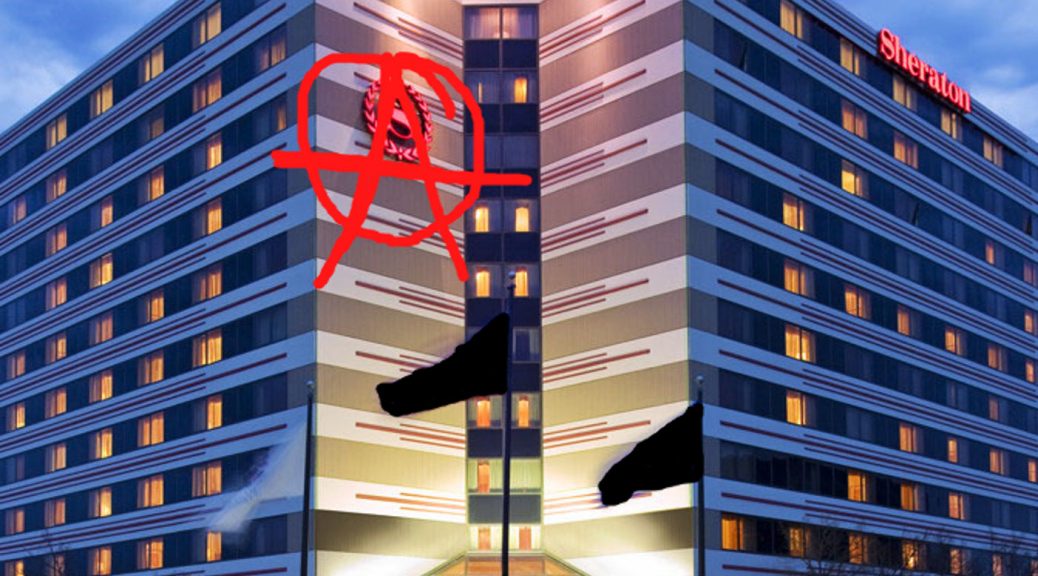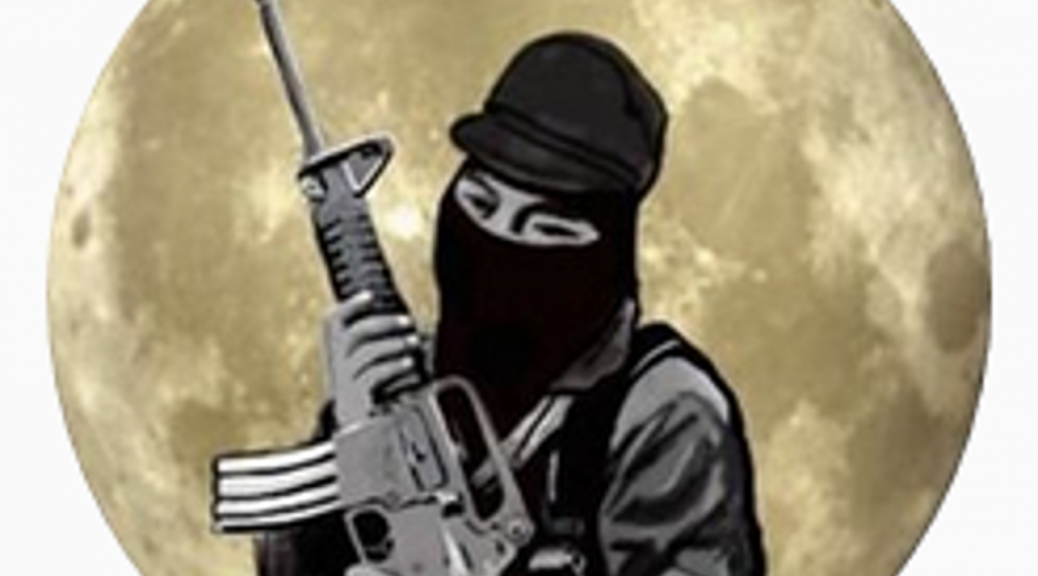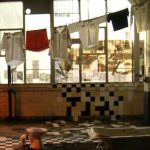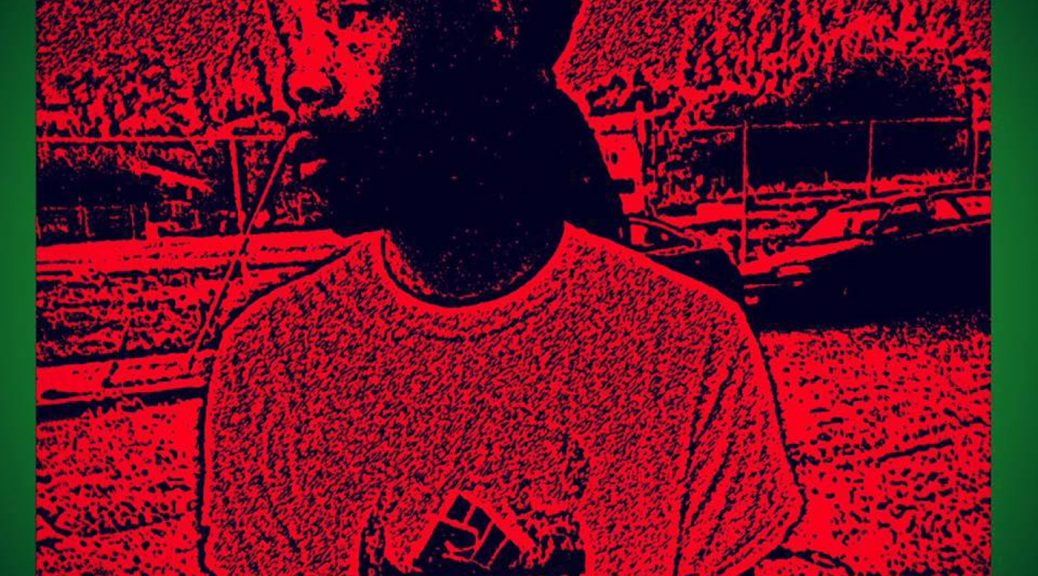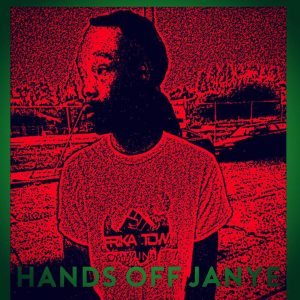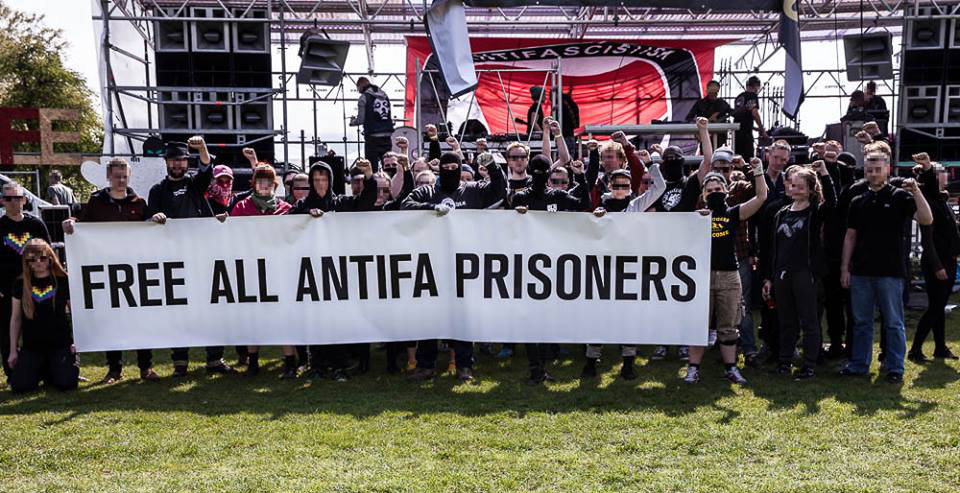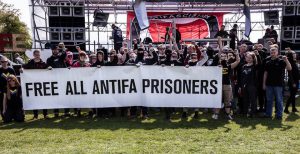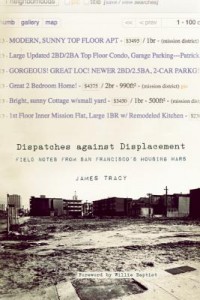Hotel Sanctuary in MPLS

This week we got to connect with Rosemary, who is an organizer in Minneapolis, about the liberation of a former Sheraton Hotel in that city and its slow but steady transformation into something that is becoming so much more than a housing cooperative. They speak about how this resocialization came to happen, some of the circumstances involved, about how this is a very deep collaboration between un-housed folks in Minneapolis and people involved in doing care work, the power of George Floyd who was profoundly involved in doing that same kind of care work with un-housed people, and many many more topics. Check out their new website up at SanctuaryHotel.org and their fundraiser at GoFundMe.com/f/SanctuaryHotel
In this episode, you’ll also hear a statement by anarchist prisoners, Comrade Malik and Sean Swain. We invite you to stay tuned for mid-week as we release a podcast special for the June 11th day of solidarity with Marius Mason and longterm anarchist prisoners. We hope to feature the voice of a longtime supporter of Marius with updates on his case, and that of anarchist prisoner, anon hacker and Federal Grand Jury resistor, Jeremy Hammond. More about June 11th on June11.org.
. … . ..
Further resources from Rosemary:
Greetings community. We hope this long post finds you as safe and well as is possible during a righteous uprising. We wanted to provide you some updates and opportunities to plug in.The Minneapolis Sanctuary Hotel is a community-led sanctuary space for over 200 displaced and homeless people who needed safety from the military occupation that occurred following the murder of George Floyd. We center values of autonomy, harm reduction, community care, mutual aid, and abolition.1. First! This page, started as a space to boost all kinds of different work related to COVID, homelessness, and community care, is transitioning to become the Minneapolis Sanctuary Hotel Facebook page. Look for changing name and photos shortly!2. We are overwhelmed with support. This is a good problem to have but we’ve had to rapidly scale up our infrastructure to meet the needs. Here are some ways to plug in:> If you are media with interview or press release requests, please email: sanctuaryhotelmedia@gmail.com> If you are a restaurant, catering company, or are interested in providing hot meals, please contact Kimberly at 612-203-2779> If you are a new volunteer looking to get connected or are a previous volunteer with a special skill set we don’t know about, please fill out this form: https://docs.google.com/forms/d/e/1FAIpQLScy9VNQ1Xnamf6pUC-kphgXrnI3OwakUucW4YAfYNVz7o5cBg/viewform3. A few boundaries to set for resident safety, capacity, and COVID reasons:> Please DO NOT show up at the sanctuary hotel if you are not signed up to work a shift.> Please NO MORE *non-perishable food* donations.> Please DO wear a mask when on-sitePlease continue to watch this space for more updates as we continue to learn and grow in the work of building a sanctuary.
. … . ..
Vigil For Fallen Comrades 6/7/2020 everywhere
From anarchist BIPOC & accomplices: Since the George Floyd rebellions began on May 26 2020, following his horrific murder by police, at least a dozen more lives have been taken by state and vigilante violence in the struggle for Black freedom. We wish to honor them by making space to say their names, commemorate their lives, and celebrate our own resistance. By acknowledging the risk we all take when we move into the streets, we remember the martyred and continue to fight for the living.
Calling for vigils everywhere, Sunday 6/7 at sundown.
. … . ..
Music for this episode by:
. … . ..
Transcription:
This week we got to connect with Rosemary, who is an organizer in Minneapolis, about the liberation of a former Sheraton hotel in that city, and it’s slow but steady transformation into something that is becoming so much more than a housing cooperative. They speak about how this re-socialization came to happen, some of the circumstances involved, about how this is a very deep collaboration between some of the un-housed folks in Minneapolis and people involved in doing care work, the power of George Floyd who was profoundly involved in doing that same kind of care work with un-housed people and many more topics.
And now some words from Comrade Malik, held by the Federal Bureau of Prisons.
Comrade Malik: Peace and blessings, sisters and brothers, peace and blessings. This is Comrade Malik, reporting in from behind enemy lines at the federal penitentiary in USP Pollock, Louisiana. I’m sure y’all have been observing the news. There is a war on black men in america. From Central Park Karen in New York to the mom who drowned her autistic son in Florida, who do they label the perpetrator of those crimes? Who is the usual suspect? The black man did it.
Like I said last year, it is not just bald headed white males with swastikas tattooed on their bodies who embrace these ideologies of hate. The millions of white women in america who embrace and practice these divisive and hateful white supremacist ideologies. [mocking voice] “Oh my god, this (?) man filming and stalking me! Someone call the police now.”
In 2020, we still ain’t free. I ain’t one of those house negroes y’all done bought. It’s me, Comrade Malik, a servant of the people.
Police in Minneapolis killed George Floyd, we all see it on national TV. Yet we have to plea and beg for justice. You call that free? Oh say can you see, I don’t feel like I’m free, locked down in a cell shackled from ankles to feet. Another day in the pen, you now hang from a string. The oppressors would love it if I hung it up, but I ain’t gonna do that.
Ahmad Arbery murdered by vigilantes in Brunswick, Georgia and now our brother George Floyd murdered by the police in Minneapolis, Minnesota. A close friend recently said that I shouldn’t mix anger with my messages. They said that you give the oppressors power when you talk about them. I don’t agree with that line of thinking. There is something horribly wrong happening right now in America. We don’t see images of young white men being pinned to the ground by police with kneeled pressed to their necks, the young white man screaming “I can’t breathe! Help me!” We don’t see that on TV.
Why do police in America feel as if it is okay to abuse, mistreat and torture back citizens in America? This is a pervasive and systemic problem. Black men and black women have feelings of anger and hopelessness when we see these images. However, violence against the police is not going to solve our problems. It may feel good for a moment, but it will only make our situation worse. We need justice and we must demand it. And we can’t allow the victimizers to tell us what justice should look like. The Minneapolis police department fired the police who were involved in the murder of George Floyd. That ain’t enough. These police should be tried for murder, they must be tried for their crime against humanity. We should never be allowed to allow law enforcement to do this to us again. However, even if they are tried and sent to prison, that will not solve our problem which is white supremacy, racism and police brutality against black men in america.
As each day passes I am drawn closer to anarchism, and it is our belief as anarchists that we the people must abolish police departments. To some, this abolition of the police may sound like a radical ideal. But please, for one minute, look at things from my perspective. Ingrained in my memory is over twelve years of abuse and torture at the hands of the Texas Department of Criminal Injustice. Ingrained in my memory are the systematic and systemic murder and executions of literally hundreds of unarmed black men and people of color by law enforcement in America. Ingrained in my memory are the children in the state of Texas, thrown into cages by ICE and Border Patrol agents, and ingrained in my memory is the bloody stain and legacy of slavery in America.
I keep saying that we want free, and like Meek Mill, I ask, ‘what’s free?’ I can tell you now, free is not what we have right now.
This is Comrade Malik, reporting in from the federal USP penitentiary at Pollack. Dare to struggle, dare to win. All power to the people.
Announcer: At the time of this recording, Comrade Malik had not heard of Breonna Taylor, and we know that there are plenty of sisters who are being cold-bloodedly murdered all across this country. We say her name, Breonna Taylor.
More of Comrade Malik’s thoughts can be found at ComradeMalik.com
Rosemary: My name is Rosemary, I use they/she pronouns, I live in Minneapolis on occupied Dakota land and I have been part of the efforts here to make a new place to live for about 250 people now, at the former Sheraton Hotel near Lake and Chicago. This was something that was made possible because of George Floyd. He gave us the power to be able to have this building. It’s hard for me to know exactly how to characterize it because it’s so new and it feels weird because we are winning and I wasn’t expecting that to happen quite so rapidly, but all thanks to George Floyd for giving us the power to carry on his legacy of supporting people experiencing homelessness by housing so many people.
TFSR:Absolutely, thanks for that. The whole really not understanding how to interface with winning is really resonating for me right now. Would you speak about your general experiences on the ground in Minneapolis since the murder of George Floyd?
Rosemary: So, I can really only speak to things in my neighborhood. I know that there have been things happening Northside, Midway and around the Twin Cities. In south Minneapolis there’s some pretty tight knit community and there’s just been so much happening. So there’s uprising that seems to have spread really far at this point and part of that is complicated so, there’s been a lot of property destructions for miles. Miles of buildings that have been burned and business that have been looted – or whatever – and it went on for days, it’s just very widespread. The landscape right now feels really different and still evolving, it’s hard for me to process what’s going to be happening during the day. There’s just a lot of energy going into a lot of different directions right now. And so during the day people would be out with brooms and trash bags, bringing out a grocery store’s equivalent of food donations by the side of the street, and people biking and driving up and down to see what was going on, and then go out at night and do it all over again.
There’s a lot of excitement that has come with things like burning the police station –
TFSR: I can only imagine.
[laughter]
Rosemary: Yeah, and like, multiple banks and large corporate retail outlet stores. And it’s complicated, there’s a lot of consequences from that in terms of food security, and family-owned, immigrant-owned, black-owned businesses and clinics and pharmacies and lot of disruption to basic needs things for people. The fires were affecting things in a major way for residents as well, and so a lot of people had to evacuate their houses in the night. There’s a number of people who lost their homes, especially if they were living above businesses. Everything has changed. I’m just trying to think about what it’s going to look like next, to think a few steps ahead. This in an area that has already faced a lot of speculation and gentrification, it’s very possible that this could accelerate that if there isn’t some organizing to address some of the land issues that we’re facing right now.
I think that the effort with commandeering this hotel will really help with propelling that in the right direction, it’s building on other tenant’s organizing that’s been happening with being able to get tenant ownership and cooperative control of the buildings that they’ve been living in so there’re been some good victories with that. In general some very strong organizing has been happening around housing issues that’s been uniting tenant’s organizing with people that have been organizing around homelessness, and un-sheltered homelessness, harm reduction work and public housing. I’m very, very excited about the ways these different communities and movements are coming together in a way that I’ve never seen. Historically it’s been hard to have housing organizers and homelessness organizers together, and particularly in the realm of homelessness, a lot of that happens through nonprofit-type, professionalized setting, and a lot of us work in that industry and that can be a limiting factor when it comes to being able to imagine more radical changes.
Right now we’re in this moment when our imaginations are all being challenged in some really new ways. We have to build back up from the ground and there are things happening that just did not seem possible. There are things happening because of the Covid pandemic that seemed impossible. The kinds of acts that I would have thought of two weeks ago seem super mellow now so being able to push ourselves to think of a horizon that seemed farther out than I realized…it’s good to be challenged in that way.
TFSR: That’s really amazing and I think that this is something that this country has not seen probably in more than a hundred years, so feeling your way forward, building up from the ground – I feel very resonant with that as well, thank you for going into that. Could you talk about how this liberation of the hotel happened, what is some context for this event; what do you see as some catalyzing moment or moments?
Rosemary: George Floyd was the catalyst. I don’t know how widely this is known but George Floyd worked at the largest homeless shelter in town for years, so there’s a lot of people that are living in the former hotel that knew him. This wouldn’t have been possible without him. He didn’t sign up to advocate like this and I don’t know how to characterize this in the right way at this point, there’s no way this would have been possible without the power that he’s given to all of us. There’s a lot of things that have happened spontaneously and I want to embrace that. This is something that we had been thinking about, and looking at, and dreaming about and thinking it would be kind of too hard to pull off for a while now. So it became possible this week and so we’re doing it, we’re just doing it and it keeps working out, I keep being surprised by all the things that are falling into place. All that’s a bit vague, I’m happy to get more into specifics if you like.
TFSR: Yeah, what I’m hearing you say is the groundwork for this thing that is unfolding before our eyes with the former Sheraton is that organizing had been laid brick by brick slowly over the years and then the catalyzing moment was George Floyd and his work and his like, people wanting to honor his memory and honor his life in this way. I’m wondering about the initial moments of the hotel takeover, are you willing to speak about that at all? I’d be really interested to hear how it happened blow by blow.
Rosemary: Yeah, and it’s weird, ‘cause there were no blows, too. I do want to make sure that it’s understood that it’s something that we’ve been organizing toward for a while and that organizing work was based on really deep relationships that people have with people that are experiencing un-sheltered homelessness in particular. And the relationships between particularly care workers and people who are experiencing un-sheltered homelessness, so people who work in the industry and have a radical analysis, people who are part of (?) Harm Reduction or other rad harm reduction outreach efforts, responses in the past to encampments in the area, native organizers since in un-sheltered homelessness here there’s just massive racial disparities – that just has to be very named and clear. So these were deep relationships that were made and expanded upon through the mutual aid organizing efforts that people have been doing all over the place in response to the COVID-19 pandemic.
There’s this really, really smart groundwork laid where we use mutual aid efforts as a deliberate response to be outside of state control, to provide sort of a wedge to force public sector, nonprofit sector to pay attention to un-sheltered experiences. So with a stay at home order closing transit, libraries and public spaces, the shelters are full, there’s nowhere to go, people’s hustles dried up, money’s tight and by sort of really strategically mobilizing the urgency of the COVID-19 pandemic and expanding the base of who is involved to be more than industry workers made this possible. It created conditions for people to have true, real relationships with our neighbors. I’m saying our…I don’t know exactly how to talk about these different kind of relationships right now, it’s complicated and I’m going to mess it up as I’m talking about because the reality is there are class and race and other divides between people who are doing care work and showing up in support of housed neighbors and people who are un-sheltered.
So those relationships were worked on really deliberately and around the country there’s been efforts. There’s empty hotels because the industry is failing due to the pandemic but there are people who don’t have a place to live. In Minnesota there are 82,000 hotel rooms and 20,000 people who are homeless – it’s obvious there’s no resource scarcity problem when you do the math, it’s an issue of distribution and choice and will and what we’re willing to do. And so around the country that’s an obvious thing and there’s been a lot of effort to reduce the concentration of crowded shelters, to reduce the spread of COVID. There have been a lot of institutional responses and it was never enough, it was systematically discriminating against people who were un-sheltered and weren’t part of a coordinated, formalized entry system. Like a poverty management model, this technocracy of how we deal with this problem of homelessness. So that’s the model that we’ve all been trying to challenge and that we’re also socialized into working and thinking in. The mutual aid work not only allowed for more people to have real relationships with unhoused neighbors, it also allowed those of us who have been working in the industry for a long time to shift the way we think about things and expand the imagination.
I want to make that clear, it’s not like these things just happened. You gotta do the groundwork, you gotta have relationships with people. You need to have actual relationships with people. That being said, the play-by-play of how we pulled this off was we tried to be really deliberate about exhausting all of our options and then moving someone in here and refusing to leave. It was exactly the right moment because the need was really obvious. The first night we had someone come in here the community paid for the room, above board. It was really necessary, the curfew had just been instituted, the national guard was invading the city as we were moving them the guard was approaching with a massive platoon of hundreds of guardsmen and armored vehicles, it was super surreal, we were very close to the third precinct and then just moving a mile down the way near Chicago and Lake to the former Sheraton hotel.
That night that intersection got real burnt, like hellscape burnt. There really were no other guests in the hotel other than journalists at that point, but there had been some families here because there’s a hospital nearby, who were here staying in the hotel because they had sick loved ones nearby. We had been looking at this site as a target for a while and were reluctant to do anything because we didn’t want to displace anyone who was staying here because they had sick family members. You know, do no harm. Then the hotel manager realized it was unsafe to be in the building with everything that was going on around, and planned to evacuate all the hotel guests out. So once we realized we wouldn’t be displacing anybody, we just went for it and crossed our fingers to see if it would work.
So we divided up roles in a way that would suit people’s talents. I got to be the talent of stubborn and just stay in the room, while other people who were more talented at negotiating with the owner did a very good job of that. The approach was just that we were trying to get another block of rooms for people who were still left behind and un-sheltered and displaced, and really just inform him that we were going to be here now. And then the owner said “Yeah”.
I mean, it took a lot of convincing and some of that convincing was having like ten of fifteen people, not even that many, who were waiting outside ready to come sit in the lobby when needed. He was inspired to say yes, and he’s still saying yes, and we now have an entire hotel, we have master keys to all the rooms, he trained volunteers in the system to make the keys so he can go home and sleep. It’s been a really interesting sort of relationship to have with the property owner. He is a motivated seller, the industry is tanked and in now the neighborhood around us the property values have tanked. We’ve essentially shamed the system into having to do something about un-sheltered homelessness in a better way and showing them what a better way is, and it’s worked.
We have a lot of support offered though county, state and city and different foundations. It’s complicated because those things can come with strings attached so we’re in a really powerful position right now and we know it. We’re taking our time and are really adamant the residents will be the ones who decide how this land will be held, and are letting things take the time that it needs to do that. It’s been a lesson in stepping into power and it’s still sinking in. People are here and are still worried about getting kicked out or this and that, and it’s sinking in now. At resident meetings (it’s majority native and black residents) people are saying things like “I used to be homeless.” There’s a woman who was saying the other day “We got our land back.” It’s not about having rooms, at really deep and fundamental level housing people is how we can redistribute land, housing is land, and we’re in need of some massive land and resource redistribution and this is one way of putting into pragmatic practice land repatriation. I’m hoping we’re able to shore up support in a way that lets that be the analysis that comes to fruition and doesn’t get sidetracked. We’re all conditioned to have constrained imaginations around this, it’s just a very unique thing.
TFSR: Thank you so much for going into that. Is there anything more you wanted to say on that topic?
Rosemary: I think we’ve been inspired by other work and I hope to learn more about what other people have been working on that we don’t know about but we’ve been inspired by Moms for Housing and the Homefulness community in Oakland who sent us a message of solidarity and support, that was really rad. There have been some actions with COVID organizing around commandeering hotels that have been limited to taking a room for a day and having some tight symbolic action with that, like some of the stuff Street (?) in LA has done, that has been cool. But like, we got an entire hotel and I think we might get another one, we got a long waiting list, and I just want that to spread.
TFSR:Absolutely. Just hearing you talk about it, I feel so activated and inspired in a good way, about what you all are doing and definitely sparking ideas on this end. We also live in an extremely hotel and tourist driven economy is that is pretty much going down the toilet right now and I’m just wondering about parallels we can draw.
Rosemary: Housing people keeps us healthy and safe. COVID has forced people to think about the impact of and connection between them because they’re afraid of getting sick from like the masses, and this is a different way of thinking about it. It has taken the awareness that I am affected by you and you are affected by me and our neighbors, and that housing people is a way of boosting people’s health and community health. This is a way of providing for health and safety in our community, not just for now but for the long term, we need to be thinking really carefully how we are responding, not just to COVID and not just to the aftermath of riots or the uprising but to this global economic depression we’re entering. How are we going to mobilize a community? If the economy in your area is failing, what are the resources and assets in the community and how can you make those community assets versus a privately held entity.
The other thing I’m exited about now is the union workers who used to work in the hotel here when it was a Sheraton, they’d been laid off I think about a month ago. And today the union workers came. The relationship between how we use our labor, how we’re grounded on the land that we’re on, all these things – it just feels really deep right now. We have the power right now, things just keep coming together.
TFSR: That’s really amazing. So the union workers came back to work at the hotel?
Rosemary: The union workers came back to see what we’re doing here, and see how they can offer support for what’s happening. I’m hopeful there can be an ongoing relationship about how organized labor and the workers who work here can be working together with the ongoing efforts here. Just as a connection point, too, shelter workers like George Floyd – it’s not like a high income job. One of the shelters in town, the starting wage is like $12/hr. Meanwhile just spitting distance from here, is a building that was not burned, a new condo building with these tiny rooms with murphy beds for like $1400 a month. So shelter workers can’t afford housing, so the connection between unionized work in a place that is now housing and what is happening in the homeless service industry is an important one to be making and is inspired by the disparate movements and communities that are coming together to learn from each other. I am learning so much right now, I feel silly being the person talking about this because there are so many people who are really solid strong organizers who have laid the groundwork work this or have been integral in making this happening. People are working their butts off to keep this going, it’s not easy, there’s a crisis around every corner but it’s happening.
TFSR: Since we only have a few minutes left I would love to ask how people, our listeners can best support y’all and are there ways folks can help get your back and send support and resources if that’s desired?
Rosemary: Yeah, the number one way would be to organize in your own community. Getting those messages of solidarity and support from other places is really really hopeful and hopefully we’ll get to the point where we can do the same for other communities as well. We’re pretty overwhelmed right now with trying to build everything up from the ground, so we’re still trying to get the infrastructure in place to handle an influx of volunteers and donations, and how to have a good system for responsibly taking in donations. I’m happy to pass on more information because I think it’ll be coming together soon here.
TFSR: Yeah, I would love to include that in the show notes. Just finally thank you so much for your time and your willingness to speak to us.
Rosemary: Yeah, thanks so much for sharing this story and I look forward to seeing what other people are doing.

